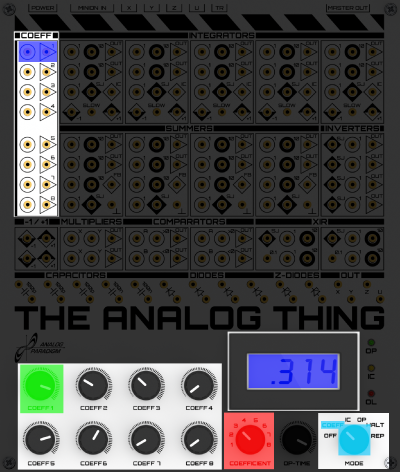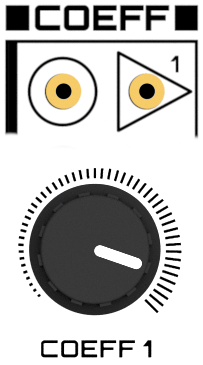Difference between revisions of "Coefficients/Potentiometers"
From TheAnalogThing
m |
|||
| Line 1: | Line 1: | ||
[[File:Coefficients-potentiometers.png|thumb|Coefficients and assigned potentiometers are on different places on the board and put here together only for visualization.]] | [[File:Coefficients-potentiometers.png|thumb|Coefficients and assigned potentiometers are on different places on the board and put here together only for visualization.]] | ||
| − | '''Coefficients''' are quantitative parameters that enter analog computations in a multiplicative fashion. Using potentiometers, | + | '''Coefficients''' are quantitative parameters that enter analog computations in a multiplicative fashion. [[The Analog Thing]] features eight coefficient potentiometers, allowing the use of up to eight coefficients in an analog computation. Using the potentiometers, each coefficient can be set to any value between <code>0</code> and <code>+1</code>. An input to a coefficient potentiometer is multiplied by the value the coefficient potentiometer is set to such that their output is given by <code>output = coefficient * input</code>. |
| − | + | Five sections of the THAT user interface relate to the use of coefficient parameters: | |
| − | |||
| − | + | * the COEFF section: these are inputs and output sockets | |
| − | + | * the potentiometer section | |
| − | + | * the MODE selector | |
| − | + | * the COEFFICIENT selector | |
| + | * the digital voltmeter | ||
| − | + | To familiarize yourself with the use of coefficient potentiometers, follow these steps: | |
| − | + | # Set the <code>MODE</code> selector to position <code>COEFF</code>. | |
| + | # Set the <code>COEFFICIENT</code> selector to <code>1</code>. | ||
| + | # Use a patch cable to connect one of the <code>+1</code> output jacks in the <code>-1 / +1</code> section to the input (circle) associated with potentiometer 1 in the <code>COEFF</code> section. | ||
| + | # Change the position of the <code>COEFF 1</code> knob in the potentiometer section and observe the value displayed on the digital voltmeter. The displayed value is available at the output (triangle) associated with potentiometer 1 in the <code>COEFF</code> section. | ||
| + | # Remove the patch cable plug from the <code>+1</code> output jack in the <code>-1 / +1</code> section and plug it into one of the <code>-1</code> output jacks in in the <code>-1 / +1</code> section. | ||
| + | # Again, change the position of the <code>COEFF 1</code> knob in the potentiometer section and observe the value displayed on the digital voltmeter. | ||
| + | # Set the <code>COEFFICIENT</code> selector to any one of the other potentiometers (say, 4). | ||
| + | # Use a patch cable to connect either of the <code>-1</code> jacks in the <code>-1 / +1</code> section with the input (circle) associated with the with the coefficient potentiometer you have chosen using the <code>COEFFICIENT</code> selector (say, 4). | ||
| + | # Change the position of the <code>COEFF</code> knob associated with the coefficient you have chosen using the <code>COEFFICIENT</code> selector (say, 4) and observe the value displayed on the digital voltmeter. | ||
[[File:Coefficients Howto.png|thumb|left|400px|How to use coefficients: Different blocks highlighted on [[The Analog Thing]] front panel]] | [[File:Coefficients Howto.png|thumb|left|400px|How to use coefficients: Different blocks highlighted on [[The Analog Thing]] front panel]] | ||
[[Category:Components of The Analog Thing]] | [[Category:Components of The Analog Thing]] | ||
Revision as of 10:58, 4 August 2021
Coefficients are quantitative parameters that enter analog computations in a multiplicative fashion. The Analog Thing features eight coefficient potentiometers, allowing the use of up to eight coefficients in an analog computation. Using the potentiometers, each coefficient can be set to any value between 0 and +1. An input to a coefficient potentiometer is multiplied by the value the coefficient potentiometer is set to such that their output is given by output = coefficient * input.
Five sections of the THAT user interface relate to the use of coefficient parameters:
- the COEFF section: these are inputs and output sockets
- the potentiometer section
- the MODE selector
- the COEFFICIENT selector
- the digital voltmeter
To familiarize yourself with the use of coefficient potentiometers, follow these steps:
- Set the
MODEselector to positionCOEFF. - Set the
COEFFICIENTselector to1. - Use a patch cable to connect one of the
+1output jacks in the-1 / +1section to the input (circle) associated with potentiometer 1 in theCOEFFsection. - Change the position of the
COEFF 1knob in the potentiometer section and observe the value displayed on the digital voltmeter. The displayed value is available at the output (triangle) associated with potentiometer 1 in theCOEFFsection. - Remove the patch cable plug from the
+1output jack in the-1 / +1section and plug it into one of the-1output jacks in in the-1 / +1section. - Again, change the position of the
COEFF 1knob in the potentiometer section and observe the value displayed on the digital voltmeter. - Set the
COEFFICIENTselector to any one of the other potentiometers (say, 4). - Use a patch cable to connect either of the
-1jacks in the-1 / +1section with the input (circle) associated with the with the coefficient potentiometer you have chosen using theCOEFFICIENTselector (say, 4). - Change the position of the
COEFFknob associated with the coefficient you have chosen using theCOEFFICIENTselector (say, 4) and observe the value displayed on the digital voltmeter.

How to use coefficients: Different blocks highlighted on The Analog Thing front panel
